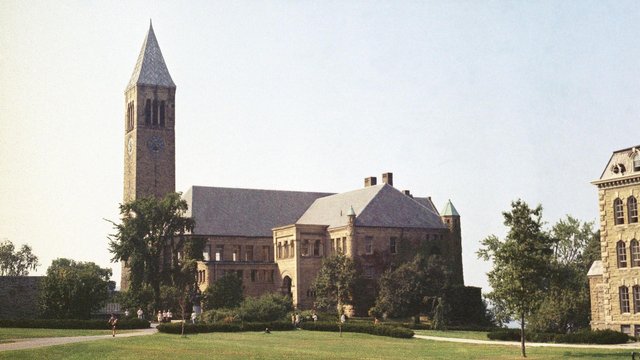Until 1975, ‘Sexual Harassment’ Was the Menace With No Name

Rain poured down in Ithaca, New York, but the women who streamed into the Greater Ithaca Activities Center on May 4, 1975 weren’t daunted by a bit of weather. Hundreds of women packed into the modest room. Then they began to speak about their experiences being groped and sexually exploited at work.
For journalist-turned activist Lin Farley, the event was life changing. “The solidarity that women felt for one another was contagious,” she later wrote. “No longer did they have to explain to their friends and family that ‘he hit on me and wouldn’t take no for an answer, so I had to quit.’ What he did had a name.”
Attendees spoke of professors, restaurant guests, factory workers, executives—men who turned their workplaces into private hells. They talked about how their bosses pinched them, groped them, and how their coworkers looked the other way when they were harassed. Humiliated, intimidated and bullied, many of these women had lost jobs when they turned down their bosses’ sexual advances. And they were fed up.
As they spoke, these women used a new term: sexual harassment. Until just a few weeks before, the term didn’t even exist. But thanks to Farley and the consciousness-raising efforts of the 1970s women’s movement, the newly coined term would not just help women give voice to their experiences: It would change U.S. law and life in the workplace.
“Working women immediately took up the phrase, which finally captured the sexual coercion they were experiencing daily,” she later wrote in The New York Times.
In 1974, Farley—a devoted feminist who lived in a radical lesbian separatist commune—was hired by Cornell University to teach a class on women and work. At the time, universities all over the country were working to catch up with the burgeoning women’s movement. Cornell was a hotbed for feminist thought and the first university in the U.S. to offer an accredited course in women’s studies. But something was awry at the university, Farley learned—it was also a hotbed for sexual harassment.

In 1975, Carmita Wood, an administrator in Cornell’s department of physics, approached Farley with a secret: Her boss, Boyce McDaniel, a celebrated physicist, had been harassing her for years. She told Farley about how McDaniel kissed and groped her, how her mental and physical health had suffered, and how she’d been denied unemployment after finally quitting in desperation. Wood wanted justice, but there was no legal definition for what she’d suffered, and no term with which to succinctly describe it.
Farley knew exactly what Wood was talking about—she, too, had witnessed harassment during her years in the workplace. So had her students, who had used Farley’s class as a place in which to discuss the sexual intimidation they’d endured during their own jobs. Farley, along with her feminist colleagues Susan Meyer and Karen Sauvigne, organized a meeting with Wood and others. They brainstormed how to refer to the problem. Was it coercion? Intimidation? Finally, recalls Farley, they settled on “sexual harassment.”
“I thought that we needed to have a name for what this phenomenon was,” Farley recalled later. “We all needed to be talking about the same thing.”
The women didn’t stop at coining a term. They joined forces, creating a group called Working Women United, bringing together women from different feminist organizations and organizing the campus speakout, which attracted 275 women. Meyer and Sauvigne commissioned a survey that found that more than 75 percent of respondents had been harassed.
Farley, armed with a new phrase to describe what women went through at work, went public with her message about harassment. In August 1975, she spoke before the Commission on Human Rights of New York City at a hearing about women in the workplace, and became the first to use the term in public. It was picked up by the New York Times in an article that used the phrase in a headline. The story, which told of the tribulations many women faced at work, was widely reprinted and helped spark a national conversation about workplace harassment.
This resulted in women around the nation having a quick shorthand with which to discuss what was happening to them. Soon, the Equal Employment Opportunity Commission came up with guidelines for lawsuits on harassment, and women began suing their employers for the groping, comments, and intimidation that, until recently, had been thought of as just part of a woman’s job. By 1977, thanks to a handful of landmark lawsuits, the courts confirmed that women could sue their employers for harassment, and today that right has been upheld for years.

Working Women United didn’t last, and Wood’s harasser was never prosecuted for his actions. But the chain of events begun by Farley and her colleagues has had long-lasting ramifications for both law and women’s everyday lives. So how does Farley feel about the term in today’s era of #metoo and widely publicized accusations of harassment?
“At first, it felt as if the term had the potential to change everything,” she wrote in the New York Times. “But…the term, which once held so much promise, has been co-opted, sanitized, stripped of its power to shock, disturb and galvanize.”
Over the years, Farley watched in dismay as the phrase became a standard part of corporate orientation sessions, intended for businesses to defend themselves against lawsuits by female employees.
“The working women’s revolution I once envisioned hasn’t happened,” she wrote recently. Though Farley recognizes that the term has sparked change in the workplace, she feels it did little to change the power dynamics that allow harassment to flourish.
Yet, without the term “sexual harassment” and its astute summary of the violations faced by women at work, we might still live in an age of furtive pinches and sexist jokes.